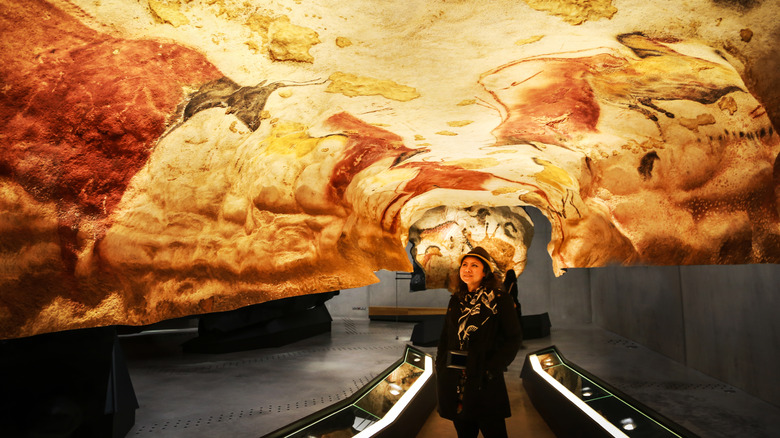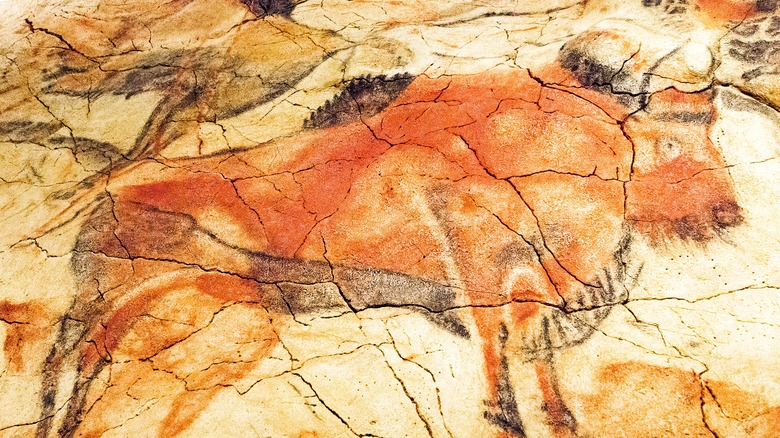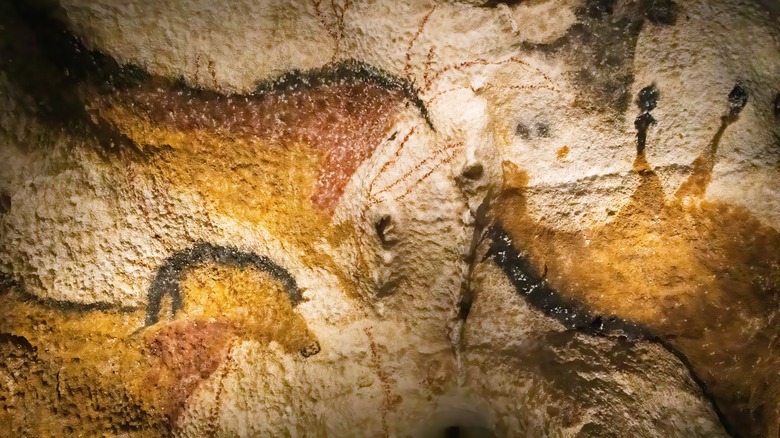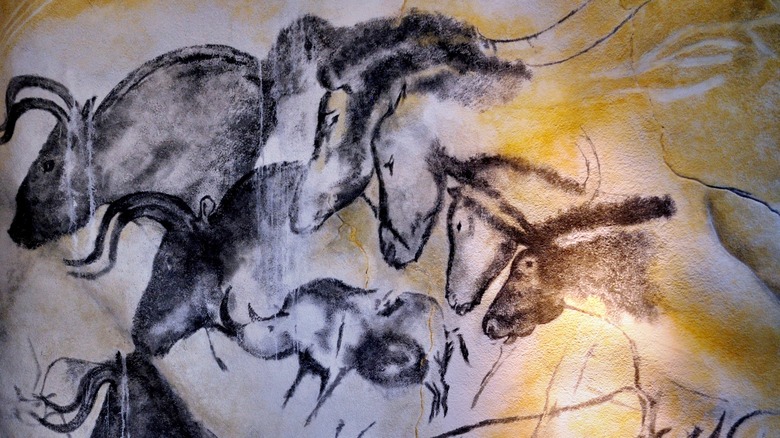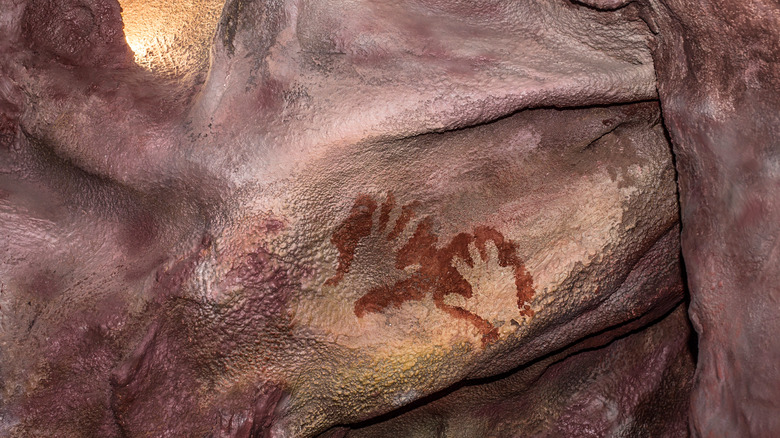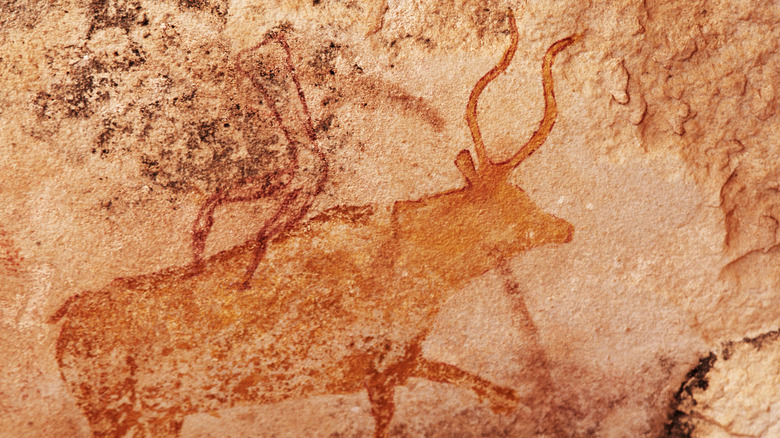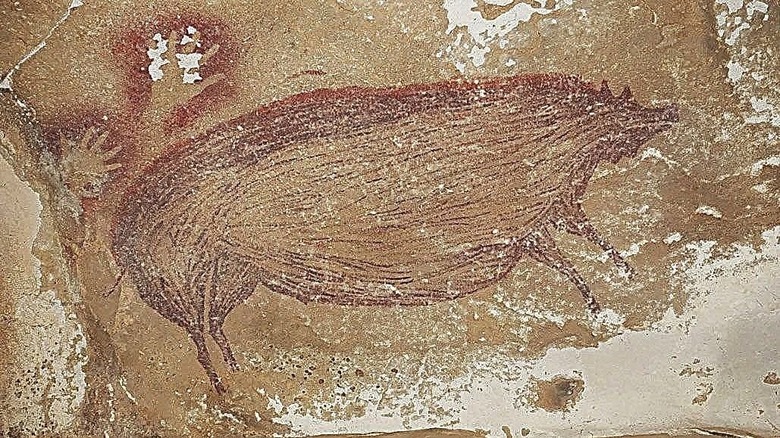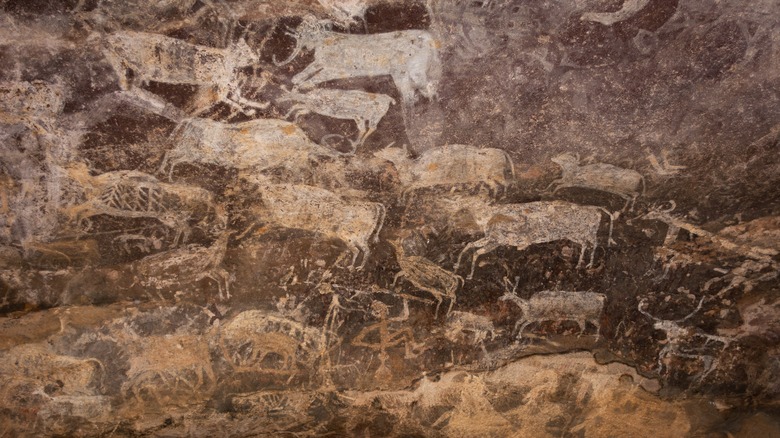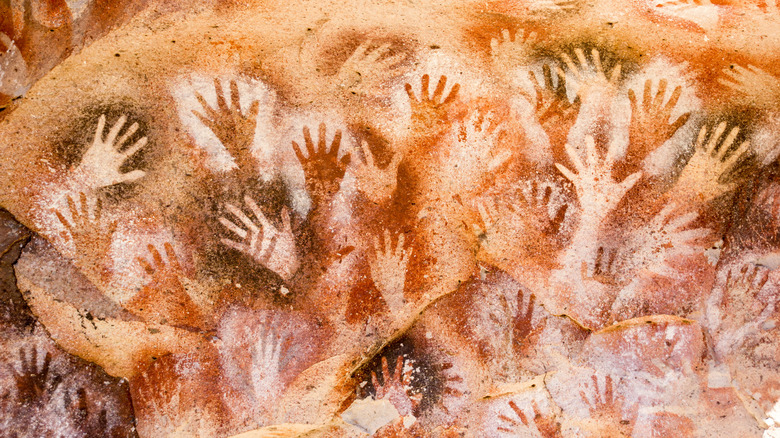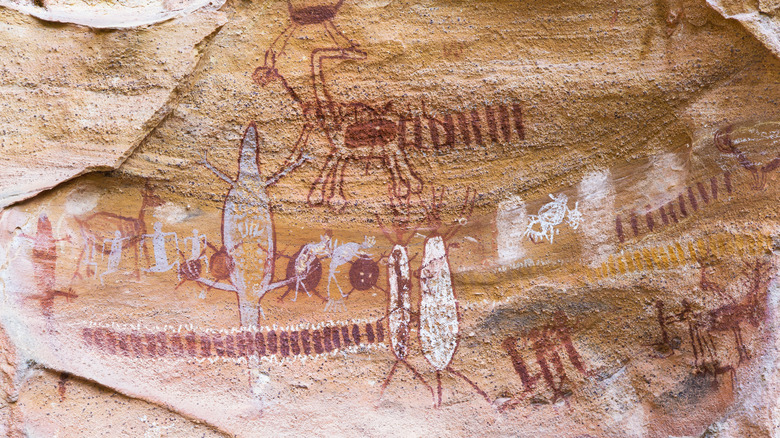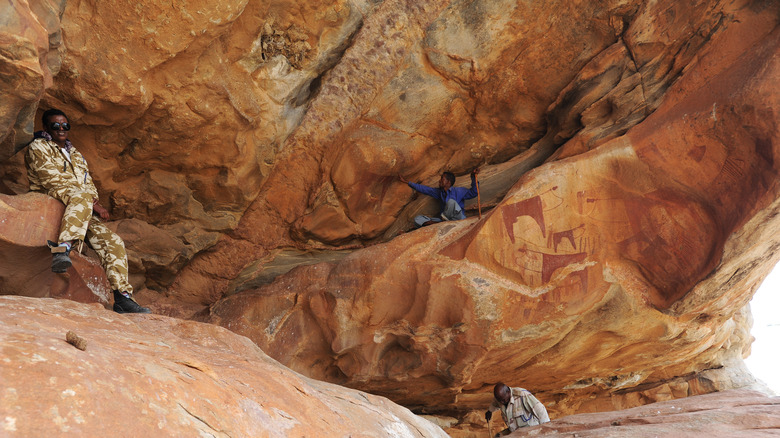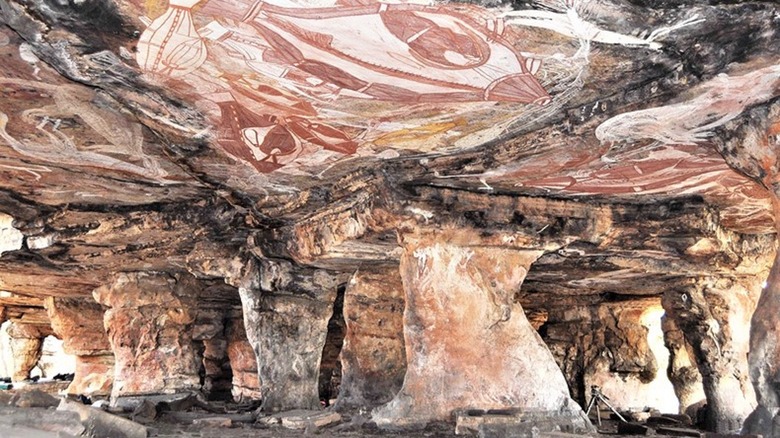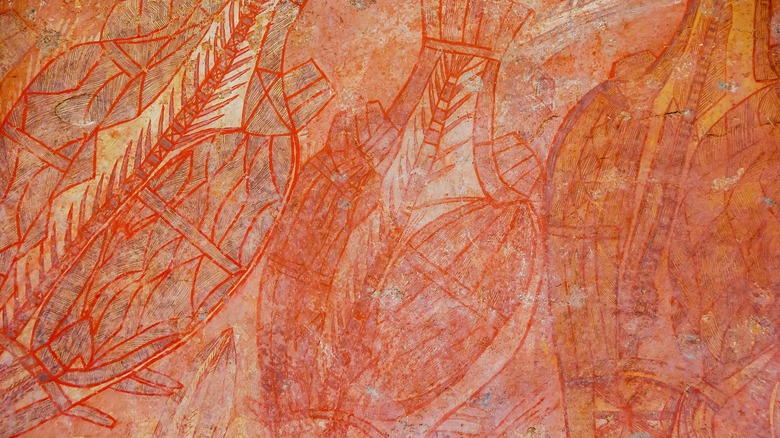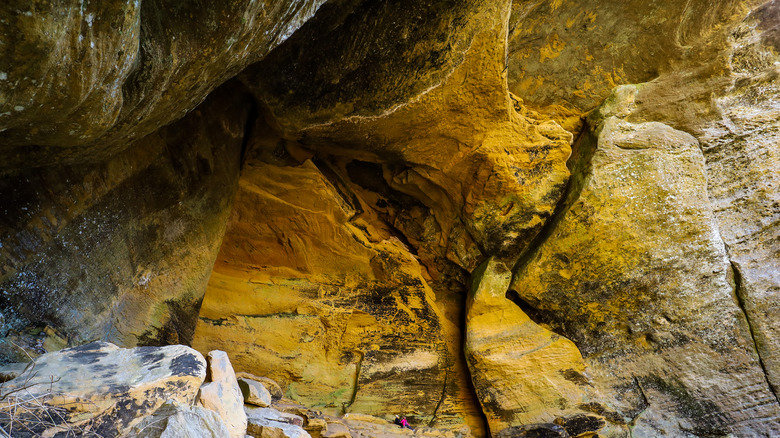The Most Incredible Cave Paintings On The Planet
Since the dawn of time, humans have created art. The earliest form of art goes back a mind-blowing 75 millennia ago when, according to History.com, early humans etched art onto a rock face in South Africa. Prehistoric art across the planet contains common themes of the natural, the supernatural, and humanity's place in the larger world. Why did these early humans create art? One MIT professor suggests that it may have helped with the development of language. This applies to cave art in particular. Certain areas of caves have an acoustical quality that, when combined with the element of evocative images, may have helped to develop human cognition.
Of course, this could all be nonsense. Even the researchers who promoted the hypothesis noted there is much we don't know. However, at the core level, humans make art for art's sake. It is believed that our ancestors had, like us, an aesthetic sense. The cave art may have been a way to express their spiritual and religious beliefs. But in truth, we may never know the real reasons. What we are left with are incredible cave paintings that are found all about the planet. These may seem mysterious on the surface, but all speak to what it means to be human. Let's take a look at some of the most outstanding examples of this early art.
Cave of Altamira
Northern Spain is the location of a cave that brought paleolithic art to the world's attention. The World History Encyclopedia explains that in 1879, the nobleman Marcelino Sanz de Sautola explored a cave that had been reported to him and made some astounding discoveries. This UNESCO World Heritage site, the Cave of Altamira, features stunning cave art which dates back to over 14,000 years ago, according to Britannica. Images include bison, horse, and deer. There are also anthropomorphic figures as well as handprints. After Sautuola published his findings, the scientific community at large was rather skeptical, asserting that prehistoric humans were not capable of such art and that the paintings were in fact fakes. However, by the end of the century, they were proved original.
Smithsonian reports that Altamira became a major tourist attraction shortly after its discovery. Visitors jammed into the caves to gawk at the eons-old work. Little did they know, however, that they were filling the cave with carbon dioxide from their breath. This so damaged the paintings that by 1977 government authorities were forced to shut the site down. From 1982 to 2002, limited visitation to Altamira was allowed until it was shut down again. As a result, an exact replica was built of the cave and paintings so tourists could visit, and only very intermittent visits to the actual cave are allowed.
Lascaux
The most famous cave art site in the world may be found in the Dordogne region of France. The World History Encyclopedia tells us that Lascaux cave is filled with about 600 paintings and 1,400 engravings. Most of these depict animals that the artists would have encountered between 15,000 and 17,000 years ago. This includes such fauna as ibex, aurochs, lions, and deer. Particularly prominent are horses, which outnumber any of the other fauna. In addition, there are also anthropomorphic figures, which researchers are still puzzling over.
Since its discovery in 1940, Lascaux has been a window into the minds of prehistoric humans. Some have suggested that the cave was used for spiritual rituals or a place where mythical stories were once told through art. The truth of the matter may never be discovered. In addition, the cave has also shown, indirectly, evidence of prehistoric long-distance trade since the materials used to make the art were only available from locations at least over 150 miles away. The site of Lascaux is so significant that it and other prehistoric sites in the Vézère Valley were declared a UNESCO World Heritage Site in 1979. Today, the cave is available to visit through a guided tour.
Chauvet
In 1994, a team led by Jean-Marie Chauvet discovered a cave in France that contains some of the most aesthetically pleasing works of prehistoric art. The cave which, as described by Britannica, bears Chauvet's name, is huge at over 91,000 square feet, but it is the 32,000-year-old art that truly makes it special. In multiple galleries are hundreds of images, mainly of animals. Fourteen species in total are represented, including wooly mammoths, horses, cave lions, megaloceros, cave bears, and bison. According to the Bradshaw Foundation, there is only one reference to a human –- an image at the farthest recess of the cave -– a representation of the lower portion of the female anatomy, which seems to be drawing the attention of another figure with the lower body of a human male and the upper body of a bison. The cave also features a large number of geometric images, including dots and strange W-shaped signs. Interestingly, the artists painted the art only in the dark recesses of the cave. It is for that reason that it is suspected that the painting of these images was a part of a ritual.
Because of the recent discovery of Chauvet, it has been on strict scientific lockdown for study and preservation. However, in order to show people this wonder of prehistoric art, Smithsonian tells us that the French government created a facsimile cave. In addition, virtual tours are available online.
Neanderthal cave art
Scattered across Spain, scientists have discovered some of the oldest works of cave art ever. Three of the most prominent caves, as reported by History.com, are La Pasiega, Maltravieso, and Ardales. The Guardian details some of this art at Ardales, which includes coloring stalagmites and stalactites using red ocher. It had long been debated whether the coloration was a natural process, but analysis shows that the pigment was applied probably by either blowing or splattering it on the formation. Other art in these caves is less subtle but still very abstract. History.com reported abstract images such as ladders, discs, and hand stencils.
According to Nature, scientists carbon-dated the images to at least 65,000 years ago. Interestingly, Homo sapiens are believed to have arrived in Europe between 45,000 and 40,000 years ago. This has led scientists to argue that these works of art were not created by modern humans, but by Homo neanderthalensis, better known as Neanderthals. These close cousins of modern humans were long thought to be intellectually inferior to modern humans, but the evidence of art suggests otherwise, including abstract thinking on par with, or equal to, modern humans.
Tadrart Acacus and Tassili N'Ajjer
In the mountainous areas of Tadrart Acacus and Tassili N'Ajjer, where western Libya abuts Algeria, are one of the most exceptional regions containing prehistoric rock art on the planet. So remarkable, in fact, that both regions have been named UNESCO World Heritage sites. Between 14,000 and 1,900 years ago, humans painted the caves with thousands of images. Because of the duration of time that elapsed while the art was made, it has become the de facto historic record of the fortunes of the Sahara desert. For example, the cave art at Tassili N'Ajjer depicts animals such as hippopotamuses, which became extinct in the Sahara as the region became desert. These animals were then slowly supplanted by others as the climate became drier.
Tadrart Acacus first show herds of cattle, which are then replaced by domesticated horses. The latest art shows camels. "From Dust to Digital" notes that the insights provided by the cave art found here have paved "the way to more nuanced reasoning about the human-environment interaction in both modern and historical context." Sadly this art, particularly in Libya, has been endangered in recent decades due to the impact of the Mu'ammar Al-Qadhdhāfī regime. This is a problem that UNESCO has been working on, especially since the dictator's assassination.
Sulawesi
One cave in Indonesia may feature the world's oldest story. In 2019, scientists described art found on a nearly 15-foot-long panel inside a cave on the island of Sulawesi. According to Nature, the panel shows reddish images of half-humans with snouts and tails engaged in a pig and buffalo hunt. One of the archaeologists who reported the findings, Adam Brumm, stated, "I've never seen anything like this before. I mean, we've seen hundreds of rock art sites in this region, but we've never seen anything like a hunting scene." Brumm and others have argued that it may actually be a scene from a now-lost ancient mythology.
What is not debated is the incredible age of this cave art. ScienceAdvances reports that carbon dating on the pigment used to make the images date to at least 43,900 years ago. Thus, if the images are indeed a scene from a mythological tale, it would make it the oldest known recorded storytelling. Also, it would be one of the earliest signs of representational and abstract thinking. It is also one of the earliest pieces of evidence of spiritual beliefs.
Bhimbetka
In the Vindhya Range in central India are the Bhimbetka rock shelters. These works of nature were carved into the sandstone rocks and then covered by the adjacent forest. They were also used by humans throughout prehistory.
According to Britannica, these caves were discovered in 1957 and subsequent exploration revealed them to contain some 700 individual shelters. They are also the largest site of prehistoric art in India. These cave paintings cover a wide swath of time. The Bradshaw Foundation cites the earliest as being some 12,000 years old with the most recent around 2,500 years old.
The images are superimposed on each other. The oldest art shows mainly large animals such as elephants, wild cattle, and large cats. In this art, humans are minor players in some hunting scenes. Art transposed over this shows domesticated animals, such as humped oxen, and vehicles such as chariots. The youngest images show soldiers fighting armed with spears, swords, and bows and arrows.
In 2003, Bhimbetka was named a UNESCO World Heritage site. Part of the reason why it was designated is that the style of the art shows a long lineage of cultural continuity in central India.
Cueva de las Manos
Cueva de las Manos translates to "Cave of the Hands." It is called this for a good reason. According to the Bradshaw Foundation, this cave in Argentina features a panel containing numerous stenciled hand paintings, which were created between 13,000 and 9,500 years ago. Upon study, researchers found that most of the hand paintings are of left hands, and they correspond in size to that of a 13-year-old boy. This has led to speculation that Cueva de las Manos was the home to some sort of initiation ritual. Aside from the hand art, there are also numerous paintings of fauna in the region including guanacos and rheas.
The guanaco, a relative of llamas, is predominant in one scene that depicts hunters using various weapons, including bolas, to take down their quarry. Cueva de las Manos, which was designated a UNESCO World Heritage site in 1999, was probably decorated by the ancestors of the Tehuelches, who inhabited Patagonia upon the arrival of Europeans.
Serra da Capivara
In northeast Brazil lies rock art that can change our perception of how the Americas were settled. According to the Bradshaw Foundation, the Serra da Capivara is a Brazilian national park and contains rock art that dates back 25,000 years ago, or earlier. The region, which would have been difficult to access for ancient people due to the steep terrain, probably had a special significance. Art is found in many places including on panels and on the ceilings of rock shelters. There are a variety of images. Many focus on animals such as armadillos, jaguars, and rhea. There are also sexual scenes, hunting montages, and supernatural panels. It seems that a story is being told.
If the art is as old as some contend, it would challenge conventional theories of human migration into the Americas, which posit that it came from the north over the Bering Land Bridge at a later time period. Instead, humans may have at least migrated into the Americas by other means (via the Bradshaw Foundation).
In 1991, Serra da Capivara was named a UNESCO World Heritage site because of its status as the remains of one of the oldest human settlement sites in the world.
Laas Geel
In Somaliland, along the Horn of Africa, exists one of the most vivid examples of prehistoric rock art in Africa. Laas Geel, which the British Museum tells us translates to "Camel's Well," consists of rock shelters located atop a granite plateau. The paintings in these shelters mainly depict horned cows painted in multiple hues, including white, red, yellow, and black. What is most evocative is the rendition of the cows. The artists gave them abnormally-shaped necks. Some suppose that this was meant to represent some sort of ritual decoration.
Aside from the cows, the artists also depicted humans in white who may be associated with or worshiping the cows. There are also dogs, a scattering of other animals, as well as geometric symbols.
The dating for Laas Geel has been challenging, but Atlas Obscura tells us that the paintings are from 5,000 to 11,000 years old. Unfortunately, the long-term preservation of Laas Geel may be precarious. Somaliland is a self-declared country that is not recognized internationally. As a result, there is little funding out there to protect the paintings from destruction and looting. They can, however, be visited although you may need an armed escort to reach them safely.
Nawarla Gabarnmang
Australia has been inhabited by humans for at least 70,000 years since the migration of humans from Southeast Asia. As with other prehistoric sites, these humans, the ancestors of today's Aborigines, created rock art. This art, according to the Metropolitan Museum of Art, dates back 40,000 years ago and is divided into three broad periods: Pre-Estuarine (ca. 40,000 to 6000 B.C.), Estuarine (ca. 6000 B.C. to A.D. 500), and Fresh Water (ca. A.D. 500 to present). These sites show a shift in styles.
One of the best-preserved aboriginal rock art sites is Nawarla Gabarnmang located in the Arnhem Land Plateau in northern Australia. According to American Scientist, this rock shelter, which first saw human inhabitants some 50,000 years ago, has been enlarged through human manipulation over eons, as inhabitants removed supporting pillars. The result is a naturalistic wonderland made more evocative with over 1,000 paintings found mainly on the ceiling. These images, as described in "The Art of Looking at Art," consist of animals such as wallabies and crocodiles as well as human figures wielding boomerangs. It has been called the "Sistine Chapel of Rock Art."
Kakadu National Park
The largest collection of ancient rock art in northern Australia is in Kakadu National Park. This UNESCO World Heritage site was first inhabited by Aborigines some 40,000 years ago. There are several highlights of the cave art in the park, with one of the most prominent being Ubirr. The paintings within this formation contain mainly images from the last 1,500 years but some may be older. For example, Ubirr contains an image of a thylacine, the so-called Tasmanian Tiger, which was thought to have gone extinct on mainland Australia between 2,000 to 3,000 years ago. Art in Ubirr was painted as recently as the 19th century.
Another prominent site in Kakadu is Burrungkuy (Nourlangie). Here there are representations of supernatural figures (one is called lightning man), images of European sailing ships, and natural fauna and flora. These sites are available to be seen in person only through ranger-guided tours.
Appalachian cave art
Typically, you do not think of cave art in the United States. However, according to The Paris Review, recent discoveries have found numerous examples in the Appalachians, particularly in the Cumberland Plateau. The first discovery came in 1979 with the finding of the so-called Mud Glyph Cave. This contains images of shells, owls, turtles, as well as warriors and people looking like birdmen. Scientists dated the paintings to about 800 years ago. Archaeology tells us that in some other sites, the art dates to over 6,000 years ago. These were mainly created by the Cherokee and their ancestors. More and more are discovered every year.
The evidence suggests that the creation of this cave art was done as a part of a ritual as had been done in other locations around the globe. These paintings were completed in the so-called "dark zones" where there was no natural light. Artists would bring in light and complete the paintings, which almost always seem to contain some kind of supernatural iconography. They were believed to be places of great spiritual importance, according to Archaeology.
